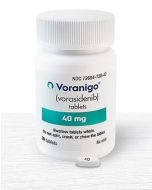Vorasidenib's EMA Approval: When Will It Be Available in Europe, the UK, and Worldwide?
Last updated: 19 August 2024

You can legally access new medicines, even if they are not approved in your country.
Learn howLow-grade gliomas are often found in otherwise healthy individuals in their 30s and 40s. They grow slowly at first, but eventually can become high-grade tumors requiring more aggressive treatments 1.
Vorasidenib, the first targeted treatment for individuals with low-grade gliomas, is receiving significant attention. Clinical trial data indicates that it has the potential for delaying tumor progression in low-grade gliomas with IDH1 or IDH2 mutations, offering a potentially life-changing option for glioma patients 1.
If you also want to know the latest about this new breakthrough in treating brain cancer, read on. We'll look at when vorasidenib is likely to get EMA approval, as well as when it will be available in Europe, the UK and beyond.
How does vorasidenib work for brain cancer?
Voranigo (vorasidenib) is a targeted therapy for brain cancer that specifically addresses gliomas with an IDH mutation, the most common primary malignant brain tumors in people under 50 2. Nearly all grade 2 gliomas, including astrocytomas and oligodendrogliomas, have this mutation.
Current treatments—surgery, radiation, and chemotherapy—are highly toxic and have significant side effects. Vorasidenib offers a crucial alternative by targeting the mutated IDH1 and IDH2 enzymes, aiming to slow down tumor growth.
How effective is vorasidenib in clinical trials?
In November 2023, data from the Phase 3 INDIGO trial was presented. These data became the basis of the FDA approval application which was submitted by vorasidenib's manufacturer in February 2024 3.
Here are some key reportings from the INDIGO trial:
- Median progression-free survival was 27.7 months for vorasidenib patients vs 11.1 months for the placebo group;
- Vorasidenib led to a 61% reduction in the risk of tumor progression or death;
- Patients treated with vorasidenib had an 83.4% likelihood of NOT receiving another treatment intervention within 24 months. The likelihood of placebo patients not needing an intervention was 27% 4,5.
These results are a glimpse of hope for low-grade glioma patients worldwide. But when will clinical trial results turn into approvals for vorasidenib? And after approval, how long until the medicine is available around the world?
Is vorasidenib approved anywhere?
Yes, in August 2024, Voranigo (vorasidenib) was granted an accelerated approval by the FDA in the USA. In addition, Vorasidenib's approval applications are under review in:
- The EU (with accelerated assessment) 6;
- Canada 7.
When will vorasidenib get EMA approval?
The timeline provided by the EMA for accelerated assessments is 150 days. However, this presupposes a decision to be taken by the EMA. by the end of June 2024, which has not happened. Such a delay is not unusual. Approval timelines can vary if the EMA needs additional data from the manufacturer. Following vorasidenib's recent FDA approval, it's likely that an EMA approval is not far behind. However, only time will tell when EU patients will be able to benefit from the treatment.
When will vorasidenib be available in Europe?
Unfortunately, getting EMA approved is only the first step. It doesn't mean that vorasidenib will be immediately available for patients throughout the EU. After EMA approval, it takes each member state a different amount of time to negotiate local prices, reimbursements, and launch a new medicine on the local market.
Germany's launch process tends to be the fastest, with an average of 102 days for orphan drugs. At the other end of the spectrum is Estonia, where it can take up to 1,081 days on average for a new medicine to become available.
This means that vorasidenib will become available to you at a different time, depending on where in Europe you are based 8.
When will Voranigo (vorasidenib) be approved in the UK?
That's more difficult to say. As of August 2024, there is no marketing authorization submitted to the MHRA for vorasidenib. However, according to post-Brexit regulations, the MHRA can decide to approve medicines locally as soon as they get the green light from another trusted regulatory body (such as the EMA or FDA). This is known as the International Reliance Procedure 9. It wouldn't be surprising if the MHRA decides to take this road for approving vorasidenib, considering the unmet treatment need for patients with low-grade gliomas in the UK.
When will vorasidenib be available in the UK?
If the MHRA approves vorasidenib simultaneously with the FDA or EMA, the medicine will then require a NICE assessment before becoming available to patients in the UK. NICE will decide whether to make vorasidenib available on the NHS. If approved, vorasidenib should be available to UK patients within three months of the decision date.
Although NICE has initiated an evaluation, no decision date has been announced 10. Assuming the best-case scenario, where the MHRA follows vorasidenib's FDA approval in August 2024, and NICE makes a positive decision soon after, vorasidenib could be available in the UK by late 2024 or early 2025.
Patients whose treatment cannot wait until then, may be able to access vorasidenib in the UK via a Compassionate use program 11.
How to get vorasidenib before it's available in your country?
Despite what the timelines above suggest, waiting is not the only option for low-grade glioma patients in Europe, the UK, or anywhere else.
Now that Voranigo (vorasidenib) has its first global approval in the USA, you can immediately access the medicine anywhere else by importing it for your personal use. This option is known as Named Patient Import, or expanded access. Here's how it works.
Vorasidenib expanded access
Even if a medicine is not yet approved or available in your country, you can legally access it. A regulation known as Named Patient Import allows you to buy and import a medicine, as long as it meets these conditions:
- it is approved somewhere;
- it is not approved or available in your country (yet);
- it has no local alternatives, and
- it is for personal use.
This process requires a prescription from your treating doctor. As in all other cases, the doctor assumes responsibility for the treatment. Per country, specific documentation requirements can vary.
Do you want to start your treatment with vorasidenib as soon as possible, using the Named Patient Import regulation? You will first need to consult your treating doctor and get a suitable prescription.
Already have a prescription? Share it with our team at Everyone.org. We can support you with buying vorasidenib as soon as it's approved somewhere in the world.
References:
- Vorasidenib Is Effective against Low-Grade Gliomas. National Cancer Institute, 27 June 2023.
- Passey, J. Recent clinical trial suggests the drug vorasidenib could offer a new treatment option for low-grade glioma. The Brain Tumour Charity, 30 June 2023.
- FDA and EMA Accept Regulatory Submissions for Vorasidenib for IDH-Mutant Diffuse Glioma. OncLive, 20 February 2024.
- INDIGO: Vorasidenib Offers Patients With IDH-Mutant Low-Grade Glioma a Means to Delay Chemotherapy and Radiotherapy. ASCO Daily News, Accessed 27 May 2024.
- Vorasidenib in IDH1- or IDH2-Mutant Low-Grade Glioma. The New England Journal of Medicine, 4 June 2023.
- FDA and EMA Accept Vorasidenib Regulatory Submissions for the Treatment of IDH-mutant diffuse glioma. Duke Research & Innovation, 21 February 2024.
- Drug and Health Product Submissions Under Review. Health Canada, Accessed 27 May 2024.
- EFPIA Patients W.A.I.T. Indicator 2021 Survey. Accessed 27 May 2024.
- Fast-Tracking Approval of Medicines - UK Publishes Detailed Guidance on its New International Recognition Procedure. Inside EU Life Sciences, 11 September 2023.
- Project information | Vorasidenib for treating astrocytoma or oligodendroglioma with IDH1 or IDH2 mutations after surgery in people 12 years and over TS ID 11974. NICE, Accessed 28 May 2024.
- Vorasidenib update for the UK brain tumour community. Brain Tumour Research, Accessed 28 May 2024.





